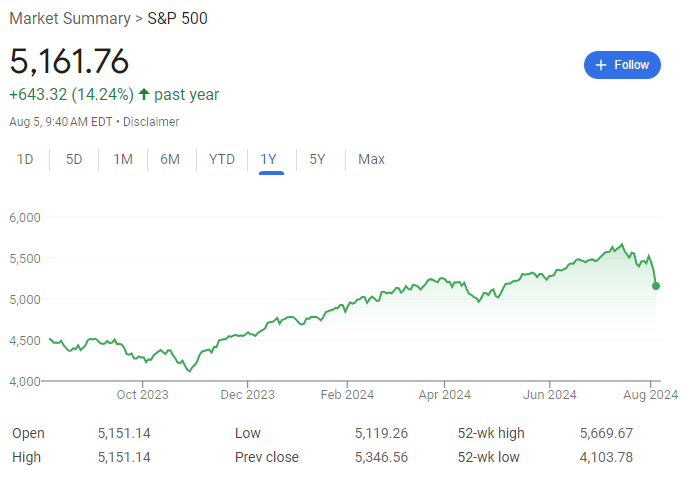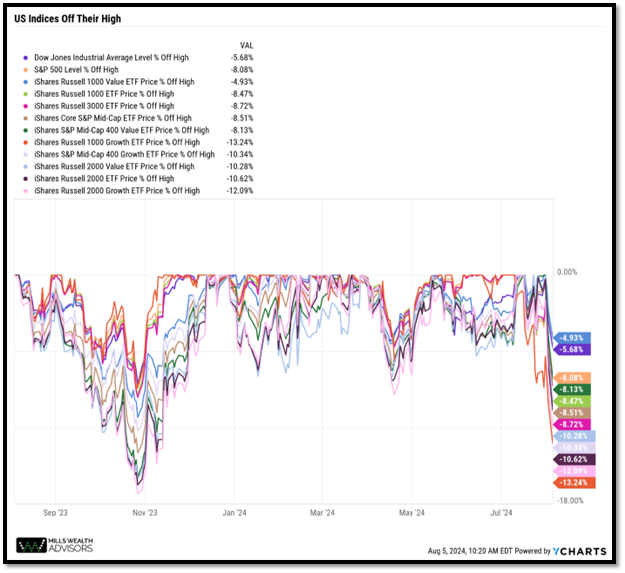By now, you have likely seen that markets across the world have been dropping on what is being called by some Black Monday 2, although that is a bit of an exaggeration. The original Black Monday occurred on October 19, 1987, when the Dow dropped 22.6% in one day. Today, the Dow is down 2.60% and we do not anticipate it getting to the 1987 level, especially the next day or so. That being said, it’s not something that we should ignore. There are 3 points that we want to quickly touch on in this email, which are “zooming out”, asset allocation, and taking advantage of market downturns.
- Zooming Out – When we see large one-day drops like we are witnessing today, at times we can feel like the sky is falling and there is no hope. It brings out the “sink or swim” or “fight or flight” instinct that is hardwired into our DNA. Fight or flight is great when you are staring down a physical danger (like a large animal), but it’s not ideal when dealing with your finances.
One way we have found to help calm your nerves is to zoom out and see where we have come from. Yes, a 3, 4, or 5% loss in one day is a huge move and could wipe out a good amount of money. However, if we compare that to where we came from, it makes it a little easier to stomach. In the past year, the S&P 500 and other indices have reached record highs, and we have come out of the lows of 2022. The 1-Year return of the S&P 500 is 14+%, even after the 3% drop we are experiencing today.

- Asset Allocation – I bet many of you could have guessed that we would bring up asset allocation in this email. We feel strongly that, if we have the right allocation, even a downturn in the market should not affect your financial future. Studies have shown that investors who went into the Dot-Com Bubble and Great Recession with a portfolio that matched their risk appetite fared much better than those who were too aggressive during that time, and their overall returns (not to mention mental health) were better. We are not advocating that a downturn similar to these is about to unfold, but we believe that, even in the worst of times, the right asset allocation is one of the most important factors in your portfolio.
- Take Advantage of Market Down Turns – If we feel we have the right asset allocation, the next step is to create a plan to take advantage of a potential market downturn. Unless you plan on spending every dollar you have tomorrow, we should look at market downturns as possibilities, not problems. Stocks are one of the few things that are looked at as bad when on sale. If we have enough fixed income on the “sidelines” to take care of immediate and near future needs and more, then we are able to use that cash to buy when stocks are on-sale.
The tricky part of this is to decide when to put that money to work, and if we should increase our stock exposure above our previous asset allocation when the market goes down. E.g. go from owning 70% stock/30% bonds to 80% stock/20% bonds. The key to these is to have a plan for the “what-ifs”. Our rule of thumb is typically to rebalance at a 20% drop in any given asset class, which we aren’t near yet as seen below in our image showing the different indices off their all-time highs. However, this strategy can be customized and changed as needed.

We don’t know if the market will go down or up from here. But what we do know is that the three principles above will help your long-term portfolio performance as well as your mental performance.
If you have any questions or want to re-evaluate your allocation or strategy to take advantage of a market downturn, please reach out and schedule time for us to talk.
